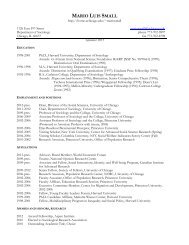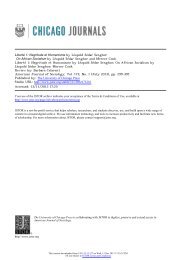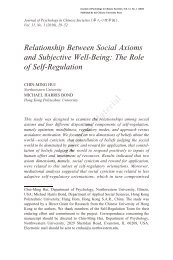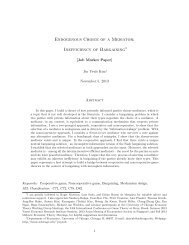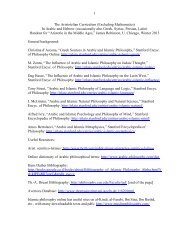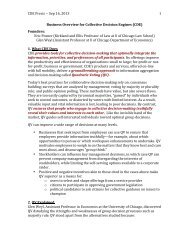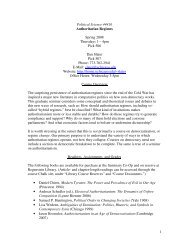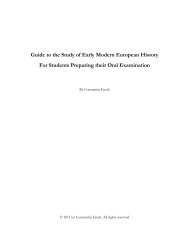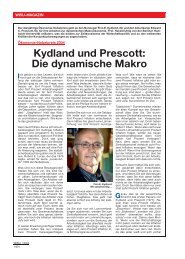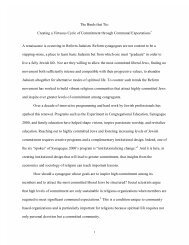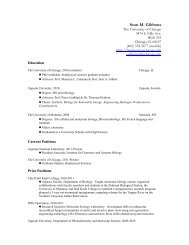Convergence Between Black Immigrants and Black Natives Across ...
Convergence Between Black Immigrants and Black Natives Across ...
Convergence Between Black Immigrants and Black Natives Across ...
Create successful ePaper yourself
Turn your PDF publications into a flip-book with our unique Google optimized e-Paper software.
vergence is driven by the higher employment probabilities of the first generation compared to the second<br />
generation. This hypothesis will be further explored in Section 6. For women, the convergence remains<br />
although it falls to 2 percentage points for labor force participants <strong>and</strong> 1 percentage point for employed<br />
women.<br />
So far we compared first <strong>and</strong> second generation blacks to native blacks. In order to put the residual race<br />
premium in a broader context, column (2) is now also performed for blacks, as well as Asians, Hispanics,<br />
<strong>and</strong> whites (Table 5 <strong>and</strong> Table 6). The results are striking. <strong>Black</strong>s are the only group that experience a<br />
decrease in the race premium when moving from the first to the second generation. This is true for both men<br />
<strong>and</strong> women. The increase in the race premia for other races reaches from one percentage point for white<br />
men to 12 percentage points for Hispanic women.<br />
Up until now, we compared races among themselves. In order to compare these estimates directly,<br />
blacks, Hispanics, <strong>and</strong> Asians are now compared to a common reference group: white natives. Furthermore,<br />
the subsequent plots will explore how these premia/penalties have evolved over time. Regressions control<br />
for education, potential experience, <strong>and</strong> state fixed effects. In addition, the regression for first generation<br />
immigrants also controls for time spent in the US. 13 Figures 2 <strong>and</strong> 3 show the earnings premium or penalty<br />
for being black, Asian, or Hispanic for men <strong>and</strong> women, respectively. The reference group is white native<br />
men for Figure 2 <strong>and</strong> white native women for Figure 3. 14 The panels are ordered in terms of time spent in<br />
the US, i.e the first, the second, <strong>and</strong> finally the third generation <strong>and</strong> beyond. 15<br />
The downward spike from 2001-2003 is associated with two phenomena. First, severe data anomalies<br />
when switching from the census to ACS from 2000 to 2001 are well established in the literature. 16 Second,<br />
September 11th led to a sharp increase in suspicion <strong>and</strong> animosity towards Muslims as well as other immigrants.<br />
However, the decrease in labor market outcomes are found to be short-lived. 17 For expositional<br />
clarity, I exclude the years 2001-2003 in Figure 4 <strong>and</strong> 5. This erases the large downward spike in the race<br />
premia of first generation immigrants.<br />
The evolution of the male race penalties in Figure 4 is striking. While Asian <strong>and</strong> Hispanic men have<br />
experienced a small increase or even a decrease in their penalties across subsequent generations. the penalty<br />
on being black increases substantially as we move from the first to the second, to the third <strong>and</strong> greater<br />
generations of blacks. Holding education, experience, <strong>and</strong> state location constant, a black immigrant male<br />
earns 17% less than a white native male in 2011. This penalty increases to 27% for a black male of the<br />
13 Due to small sample sizes, years 2004-2006, 2007-2009, <strong>and</strong> 2010-2011 are pooled for the ACS samples. For the CPS samples<br />
1994-1998, 1999-2003, 2004-2008, <strong>and</strong> 2009-2012 are pooled.<br />
14 Focusing exclusively on employed individuals do not change the main take-aways as Figure A.1 <strong>and</strong> Figure A.2 demonstrate.<br />
Figures are cut off at 1990 to make the comparison with the second generation easier (1994 <strong>and</strong> beyond). Figure A.3 <strong>and</strong> Figure A.4<br />
depict the same race premia from 1970 onwards<br />
15 The 95% confidence intervals on Figures 2 through 12, as well as A.1 through A.5 are very tight, barely visible, <strong>and</strong> therefore not<br />
depicted.<br />
16 The driving differences seem to come from the unemployed.<br />
17 Kaushal et al. (2007) find that September 11th was associated with a 9-11 percent decline in the real wage <strong>and</strong> earnings of Arab<br />
<strong>and</strong> Muslim men. Orrenius <strong>and</strong> Zavodny (2006) find a decline in employment <strong>and</strong> earnings among Hispanic immigrants. These are just<br />
a select few among many papers exploring the effect of September 11th on labor market outcomes of different types of immigrants.<br />
8



